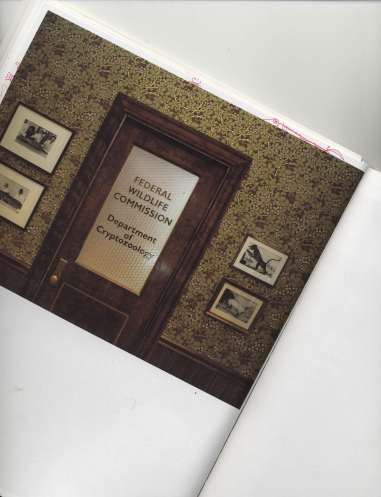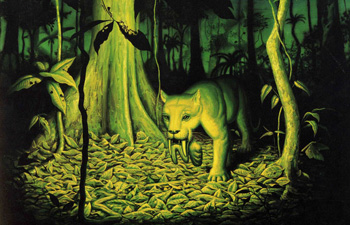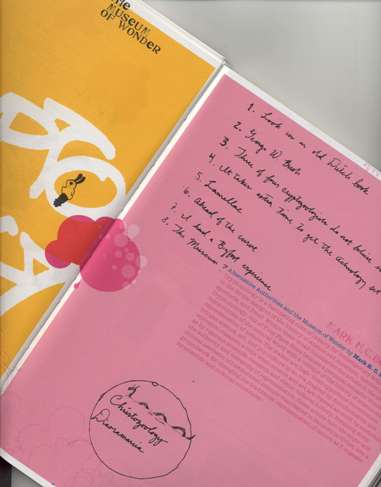Review: Cryptozoology Out of Time Place Scale
Posted by: Loren Coleman on December 2nd, 2006
This image of the front cover for the book may be clicked on to enlarge it.
The following is a contributed review sent in to share with you, by Craig Heinselman, Editor CRYPTO. The photographs, most by Luc Demers, are scans I’ve added to the review from the book.
Cryptozoology Out of Time Place Scale
Mark Bessire and Raechell Smith, editors
JRP / Ringier, 2006
ISBN: 3-905770-07-5 & 978-3-905770-07-0
$29.95

The door opens at the office of the Federal Wildlife Commission’s Department of Cryptozoology, situated near the offices of the Bureau for the Investigation of Paranormal Phenomenon and the National Institute of Comparative Astrobiology, and the creature curiosities of the world are revealed. Of course, these doors are staged. These bureaus, commissions and institutes do not exist. But, what they hold behind their staged entranceways does, the world of cryptozoology through an eclectic collection of art, history and fact.

Cryptozoology: Out of Time Place Scale, is an exhibit organized by the Bates College Museum of Art and the H&R Block Artspace at the Kansas City Art Institute. The exhibit started in June 2006 at the Bates College Museum of Art, and moved to the Kansas City Art Institute in late October 2006. Its companion book has been provided the same title as the exhibit, and allows the lookers a chance to see part of the exhibit, but also feel the exhibit itself through a book that is art unto itself.
One can not explain the layout and the books unique structure sufficiently, but suffice it to say it does not follow any standard practice for a softcover or hardcover, its design, structure, imprint, layout and texture are as specialized as the content and basis for its creation. One must see, hold and look at it to obtain a true sense.

If you were to pick this book strictly as a text on “mystery animals”, you would be mistaken. Its intent is not that, nor is its content. But, if you were to pick this book as a historical representation of art, you would be correct. That is the core of the book, extracting the artistic talents and viewpoints of contributors to the subject matter and content of cryptozoology.

We see a photographic representation of a still from the famed Patterson Film by Ellen Lesperance and Jeanine Oleson entitled Bigfoot & Nioka II. We see an acrylic and graphite piece by Walmor Correa in the style of a physicians guide entitled Capelobo from Project Unheimlich. And, this reviewers’ favorite, an oil and acrylic piece on wood paneling entitled Map of Cryptozoology by Alexis Rockman showing a global perspective on all things cryptozoological. These entries are but a taste of the art styles within the book, and exhibit itself, which range including photographic, taxidermy sculptures, line drawings, doodles, acrylic, oil and more.

Not to be outdone though there are essays throughout the book. While the historical entry by Loren Coleman is well written, it is overshadowed, rightfully so, by other entries. Primary to the overshadowing though is Sean Foley’s Cryptozoology as Art, which is presented in an artistic manner itself consisting of 52 verses. Not only is its style intriguing, but the content is well done. One such entry is from verse 21, and reads:
“Art, myth, and, in this case, cryptozoology exist as a hub for emotional, sensual, and proactively idiosyncratic “what ifs” and experiential open-minded symbolic images. This is the value of the arts: total immersion in subjectivity and a collective safe harbor for experimental, thoroughly considered intellectual constructions. The museum, particularly the art museum, in spite of its canonically taming tendencies, is a publicly sanctioned containment bureaucracy for displaying wildly conceptualized freaks, artful constructions.”
The book is not for everyone, as it does require an interest in art and its various interpretations. One may find some entries odd, and out of place, but this in reality is a true testament to what art is as Sean Foley elegantly outlined above. One will not walk away with a new theory or idea in cryptozoology, but you do walk away with a different viewpoint on how art can be presented both in concept, implementation and presentation.
Perhaps it will inspire more artists to join in……

About Loren Coleman
Loren Coleman is one of the world’s leading cryptozoologists, some say “the” leading living cryptozoologist. Certainly, he is acknowledged as the current living American researcher and writer who has most popularized cryptozoology in the late 20th and early 21st centuries.
Starting his fieldwork and investigations in 1960, after traveling and trekking extensively in pursuit of cryptozoological mysteries, Coleman began writing to share his experiences in 1969. An honorary member of Ivan T. Sanderson’s Society for the Investigation of the Unexplained in the 1970s, Coleman has been bestowed with similar honorary memberships of the North Idaho College Cryptozoology Club in 1983, and in subsequent years, that of the British Columbia Scientific Cryptozoology Club, CryptoSafari International, and other international organizations. He was also a Life Member and Benefactor of the International Society of Cryptozoology (now-defunct).
Loren Coleman’s daily blog, as a member of the Cryptomundo Team, served as an ongoing avenue of communication for the ever-growing body of cryptozoo news from 2005 through 2013. He returned as an infrequent contributor beginning Halloween week of 2015.
Coleman is the founder in 2003, and current director of the International Cryptozoology Museum in Portland, Maine.










